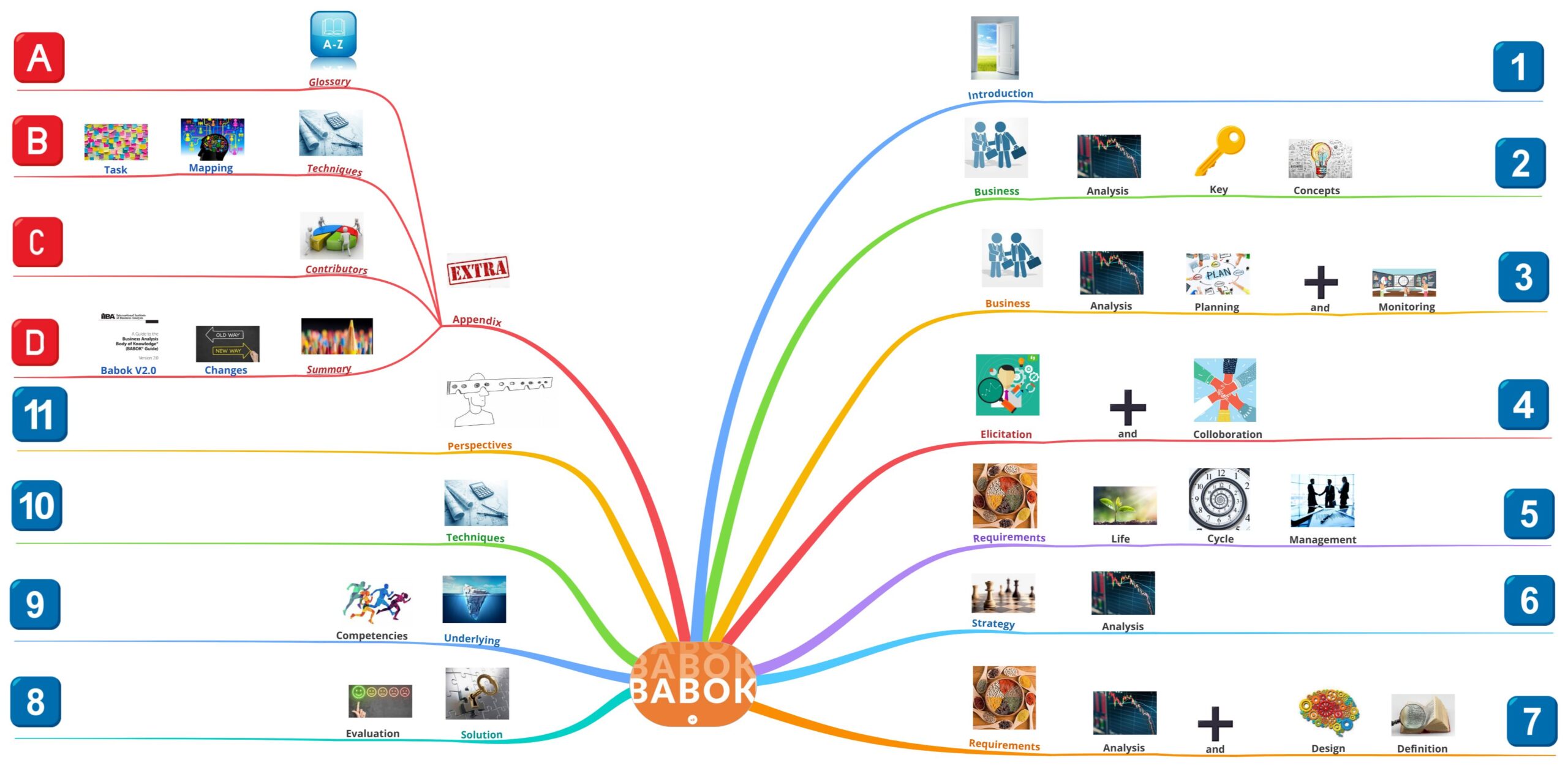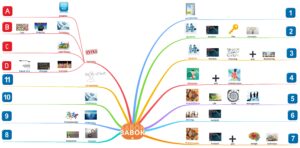BABOK (a.k.a., BABOK Guide), one of the most important publications of IIBA, “International Institute of Business Analysis“. It is the ultimate reference for the ones who are interested in Business Analysis, a discipline of research. BABOK stands for “Business Analysis Body of Knowledge” and it serves as a guide to the activities of this discipline. The latest BABOK has the version number three and this article introduces the table of contents of BABOK (v3) in brief with the following mind map:
Chapter 1: Introduction
Firstly in this section the purpose of the BABOK Guide is introduced. Secondly the definition of the Business Analysis is made. Thirdly the possible Bussiness Analyst roles are explained. Lastly the structure of the BABOK (v3) is described which makes up the BABOK Guide‘s format. A little detailed expression of this structure is as follows:
1.4 Structure of The BABOK Guide
Basically the content in the center of the BABOK Guide consists of business analysis tasks organized into knowledge areas. These tasks are (not sequentially but) logically related to each other in their respective knowledge areas. “The Business Analysis Key Concepts“, “Underlying Competencies“, “Techniques“, and “Perspectives” sections extend the core content in the BABOK Guide helping business analysts to perform better in business analysis tasks. Whereas the knowledge areas have a common structure, these extended contents have their own specific structures.
1.4.1 Key Concepts
Providing a basic understanding of the main ideas required to understand the BABOK Guide, some key concepts are introduced in Chapter 2.
1.4.2 Knowledge Areas
Certain business analysis funcionality areas include related tasks which form knowledge areas. Each knowledge area has its own group of tasks, but in all knowledge areas tasks are presented in similar format in the BABOK Guide.
1.4.3 Tasks
Tasks are discrete pieces of works may be performed and are grouped into knowledge areas and can be performed from all knowledge areas sequentially, iteratively, or simultaneously. The BABOK Guide has the following format for the tasks of the knowledge areas:
- Purpose
- Description
- Inputs
- Elements
- Guidelines/Tools
- Techniques
- Stakeholders
- Outputs
1.4.4 Underlying Competencies
One can successfully perform the business analysis role with the help of underlying competencies which reflect knowledge, skills, behaviours, characteristics and personal qualities. The BABOK Guide has the following format for the underlying competencies:
- Purpose
- Definition
- Effectiveness Measures
1.4.5 Techniques
On ways that a task may be performed, techniques provide additional information. The BABOK Guide has the following format for the techniques:
- Purpose
- Description
- Elements
- Usage Considerations
1.4.6 Perspectives
To provide focus to tasks and techniques specific to the context of the initiative, perspectives are used within business analysis work. The BABOK Guide has the following format for the perspectives:
- Change Scope
- Business Analysis Scope
- Methodologies, Approaches, and Techniques
- Underlying Competencies
- Impact on Knowledge Areas
Chapter 2: Business Analysis Key Concepts
The first key concept introduced in this section is the BACCM, “Business Analysis Core Concept Model“; serves as a conceptial framework for business analysis.
The second key concept introduced in this section is the Key Terms; maintain the definitions of main concepts.
The third key concept introduced in this section is Requirements Classification Schema; helps the stakeholders in categorizing the requirements.
The fourth key concept introduced in this section is Stakeholders; possible participators in the execution of the tasks related to the requirements.
The fifth key concept introduced in this section Requirements and Designs; includes a comparison between a requirement and a design.
Chapter 3: Business Analysis Planning and Monitoring
According to the structure stated in the section “1.4.3 Tasks” following tasks are explained in this knowledge area:
- Plan Business Analysis Approach
- Plan Stakeholder Engagement
- Plan Business Analysis Governance
- Plan Business Analysis Information Management
- Identify Business Analysis Performance Improvements
Chapter 4: Elicitation and Collaboration
According to the structure stated in the section “1.4.3 Tasks” following tasks are explained in this knowledge area:
- Prepare for Elicitation
- Conduct Elicitation
- Confirm Elicitation Results
- Communicate Business Analysis Information
- Manage Stakeholder Collaboration
Chapter 5: Requirements Life Cycle Management
According to the structure stated in the section “1.4.3 Tasks” following tasks are explained in this knowledge area:
- Trace Requirements
- Maintain Requirements
- Prioritize Requirements
- Assess Requirements Changes
- Approve Requirements
Chapter 6: Strategy Analysis
According to the structure stated in the section “1.4.3 Tasks” following tasks are explained in this knowledge area:
- Analyze Current State
- Define Future State
- Assess Risks
- Define Change Strategy
Chapter 7: Requirements Analysis and Design Definition
According to the structure stated in the section “1.4.3 Tasks” following tasks are explained in this knowledge area:
- Specify and Model Requirements
- Verify Requirements
- Validate Requirements
- Define Requirements Architecture
- Define Design Options
- Analyze Potential Value and Recommend Solution
Chapter 8: Solution Evaluation
According to the structure stated in the section “1.4.3 Tasks” following tasks are explained in this knowledge area:
- Measure Solution Performance
- Analyze Performance Measures
- Assess Solution Limitations
- Assess Enterprise Limitations
- Recommend Actions to Increase Solution Value
Chapter 9: Underlying Competencies
According to the structure stated in the section “1.4.4 Underlying Competencies” following competencies are explained in this extended content:
- Analytical Thinking and Problem Solving
- Creative Thinking
- Decision Making
- Learning
- Problem Solving
- Systems Thinking
- Conceptual Thinking
- Visual Thinking
- Behavioural Characteristics
- Ethics
- Personal Accountability
- Trustworthiness
- Organization and Time Management
- Adaptability
- Business Knowledge
- Business Acumen
- Industry Knowledge
- Organization Knowledge
- Solution Knowledge
- Methodology Knowledge
- Communication Skills
- Verbal Communication
- Non-Verbal Communication
- Written Communication
- Listening
- Interaction Skills
- Facilitation
- Leadership and Influencing
- Teamwork
- Negotiation and Conflict Resolution
- Teaching
- Tools and Technology
- Office Productivity Tools and Technology
- Business Analysis Tools and Technology
- Communication Tools and Technology
Chapter 10: Techniques
According to the structure stated in the section “1.4.5 Techniques” following techniques are explained in this extended content:
- Acceptance and Evaluation Criteria
- Backlog Management
- Balanced Scorecard
- Benchmarking and Market Analysis
- Brainstorming
- Business Capability Analysis
- Business Cases
- Business Model Canvas
- Business Rules Analysis
- Collaborative Games
- Concept Modelling
- Data Dictionary
- Data Flow Diagrams
- Data Mining
- Data Modelling
- Decision Analysis
- Decision Modelling
- Document Analysis
- Estimation
- Financial Analysis
- Focus Groups
- Functional Decomposition
- Glossary
- Interface Analysis
- Interviews
- Item Tracking
- Lessons Learned
- Metrics and Key Performance Indicators (KPIs)
- Mind Mapping
- Non-Functional Requirements Analysis
- Observation
- Organizational Modelling
- Prioritization
- Process Analysis
- Process Modelling
- Prototyping
- Reviews
- Risk Analysis and Management
- Roles and Permissions Matrix
- Root Cause Analysis
- Scope Modelling
- Sequence Diagrams
- Stakeholder List, Map, or Personas
- State Modelling
- Survey or Questionnaire
- SWOT Analysis
- Use Cases and Scenarios
- User Stories
- Vendor Assessment
- Workshops
Chapter 11: Perspectives
According to the structure stated in the section “1.4.6 Perspectives” following perspectives are explained in this extended content:
- Agile
- Business Intelligence
- Information Technology
- Business Architecture
- Business Process Management
Appendix A: Glossary
In Appendix A, a glossary exists for all important words and phrases lie in the BABOK Guide.
Appendix B: Techniques to Task Mapping
In Appendix B, a table demonstrating the match status between the techniques mentioned in the “Chapter 10: Techniques” and the tasks of the related knowledge areas exists.
Appendix C: Contributors
In Appendix C, the contributors for the BABOK Guide are listed.
Appendix D: Summary of Changes from BABOK Guide v2.0
In Appendix D, the differences between BABOK Guide (v3) and BABOK Guide (v2.0) are stated and emphasized.

